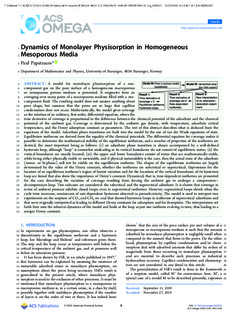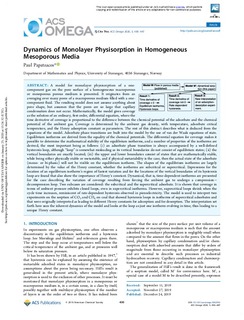| dc.contributor.author | Papatzacos, Paul Georg | |
| dc.date.accessioned | 2020-01-28T10:18:58Z | |
| dc.date.available | 2020-01-28T10:18:58Z | |
| dc.date.created | 2019-12-27T11:01:20Z | |
| dc.date.issued | 2019-12 | |
| dc.identifier.citation | Papatzacos, P. (2020) Dynamics of monolayer physisorption in homogeneous mesoporous media, ACS Omega, 5(1). | nb_NO |
| dc.identifier.issn | 2470-1343 | |
| dc.identifier.uri | http://hdl.handle.net/11250/2638290 | |
| dc.description | This is an open access article published under an ACS AuthorChoice License, which permits copying and redistribution of the article or any adaptations for non-commercial purposes. | nb_NO |
| dc.description.abstract | A model for monolayer physisorption of a one-component gas on the pore surface of a homogeneous macroporous or mesoporous porous medium is presented. It originates from an averaging over many pores of a macroporous medium filled with a one-component fluid. The resulting model does not assume anything about pore shape, but assumes that the pores are so large that capillary condensation does not occur. Mathematically, the model gives coverage as the solution of an ordinary, first-order, differential equation, where the time derivative of coverage is proportional to the difference between the chemical potential of the adsorbate and the chemical potential of the ambient gas. Coverage is determined by the ambient gas density, with temperature, adsorbate critical temperature, and the Henry adsorption constant as parameters. The rest of this abstract describes what is deduced from the equations of the model. Adsorbate phase transitions are built into the model by the use of van der Waals equations of state. Equilibrium isotherms are derived from the equality of the chemical potentials. The differential equation for coverage makes it possible to determine the mathematical stability of the equilibrium isotherms, and a number of properties of the isotherms are derived, the most important being as follows: (i) an adsorbate phase transition is always accompanied by a well-defined hysteresis loop, although “loop” is somewhat misleading as its vertical boundaries do not consist of equilibrium states; (ii) the vertical boundaries are exactly located; (iii) the upper and lower boundaries consist of states that are mathematically stable, while being either physically stable or metastable, and if physical metastability is the case, then the actual state of the adsorbate (mono- or bi-phasic) will not be visible on the equilibrium isotherm. The shapes of the equilibrium isotherms are largely determined by the value of the Henry constant, whether the isotherms are subcritical or supercritical. Expressions for the location of an equilibrium isotherm’s region of fastest variation and for the locations of the vertical boundaries of its hysteresis loop are found that also show the importance of Henry’s constant. Dynamical, that is, time-dependent isotherms are presented for the case describing the variation of coverage resulting from forcing the ambient gas to undergo a compression–decompression loop. Two subcases are considered: the subcritical and the supercritical adsorbate. It is shown that coverage in terms of ambient pressure exhibits closed loops, even in supercritical isotherms. However, supercritical loops shrink when the cycle time increases, reminiscent of rate-dependent hysteresis observed in piezoelectricity. The model is used to interpret two experiments on the sorption of CO2 and CH4 on coal that showed hysteresis loops in isotherms of supercritical adsorbates and that were originally interpreted as leading to different Henry constants for adsorption and for desorption. The interpretation set forth here uses the inherent dynamics of the model and looks at the loop as just one isotherm evolving in time, thus leading to a unique Henry constant. | nb_NO |
| dc.language.iso | eng | nb_NO |
| dc.publisher | American Chemical Society | nb_NO |
| dc.subject | kjemi | nb_NO |
| dc.subject | væske | nb_NO |
| dc.subject | adsorpsjon | nb_NO |
| dc.subject | equilibrium hysteresis | nb_NO |
| dc.title | Dynamics of monolayer physisorption in homogeneous mesoporous media | nb_NO |
| dc.type | Journal article | nb_NO |
| dc.type | Peer reviewed | nb_NO |
| dc.description.version | publishedVersion | nb_NO |
| dc.rights.holder | © 2019 American Chemical Society | nb_NO |
| dc.subject.nsi | VDP::Matematikk og Naturvitenskap: 400::Kjemi: 440 | nb_NO |
| dc.source.pagenumber | 18 | nb_NO |
| dc.source.volume | 5 | nb_NO |
| dc.source.journal | ACS Omega | nb_NO |
| dc.source.issue | 1 | nb_NO |
| dc.identifier.doi | 10.1021/acsomega.9b02956 | |
| dc.identifier.cristin | 1763926 | |
| dc.relation.project | Norges forskningsråd: 230303 | nb_NO |
| cristin.unitcode | 217,8,2,0 | |
| cristin.unitname | Institutt for matematikk og fysikk | |
| cristin.ispublished | true | |
| cristin.qualitycode | 1 | |

